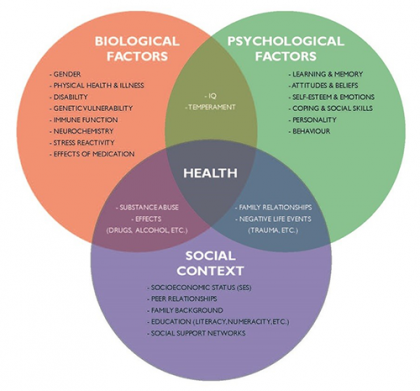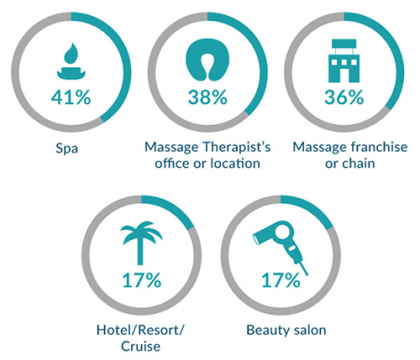The Value of Continuing Education and Collaboration to Advance the Field of Massage Therapy
- Advanced Neuromuscular Therapy Program
- Core Massage Therapy Training Program
- Health & Wellness
- Massage Therapy

“Even though athletic trainers, physical therapists and other health care professionals all do some manual therapy, they don’t have the training or experience a Massage Therapist has…Likewise, Massage Therapists are expanding their skills but don’t have the training an athletic trainer or physical therapist has. So, when we have the opportunity to work together, we can all learn from each other, and that makes us all better health care providers.1”
Massage Therapy Industry Trends
The American Massage Therapy Association’s 2021 Massage Profession Research Report indicates that 92% of consumers considered massage to be effective in reducing pain; and 93% of consumers feel massage can be beneficial to health and wellness. Additionally, 63% of all consumers received their last massage for health and wellness reasons which include:
- Soreness/stiffness/muscle spasm – 33%
- Pain relief/management – 29%
- Keeping fit/healthy/wellness – 22%
- Control headaches/migraines – 10%
- Injury recovery/rehabilitation – 9%
- Pregnancy/Prenatal – 3%
Of the consumers that discussed massage therapy with their doctor or health care provider, 25% were referred to a Massage Therapist, 24% were strongly recommended to get a massage by their health care provider, and 23% were encouraged to get a massage. Only 2% of those surveyed indicated their health care provider discouraged them from getting a massage. These numbers are incredibly encouraging since most “medical training and residency don’t typically include any training about massage therapy, so many physicians in traditional medical environments likely don’t fully understand the demonstrated benefits of massage.”1
According to the AMTA 2012 Massage Profession Research Report, the consumers indicated that physicians were the highest source of referral at 50%. Physical Therapists, Chiropractors, and Mental Health Professionals were also large proponents of massage therapy for their patients. It is interesting that within the hospital environment that many feel “nurses, too, are likely going to be the ones who recognize the need for massage therapy. ‘Oftentimes, it is the nursing team that recognizes that massage therapy may help their patient, and they reach out to the physicians to get the order in place for the patient.”2
Required Knowledge for Massage Therapists
With consumers and health care practitioners beginning to see the benefits of massage therapy in health and wellness, the question becomes, what do massage therapists need to do to meet the needs of these populations? Diane Hood, BCMT, LMT says, “…massage therapist(s) needs to know basic kinesiology terminology and principles.”3 She also states, massage therapists “use their knowledge and experience to identify techniques that support an athlete’s recovery from a properly diagnosed injury or surgery.”3 This position indicates a Massage Therapist must understand pathologies, rehabilitation interventions, stages of healing, and the critical thinking necessary to apply the appropriate massage techniques throughout the healing process. Cynthia Ribeiro, founder of the Advanced Neuromuscular Therapy Program at National Holistic Institute | A College of Massage Therapy has often stated that she will identify an exceptional therapist as one who knows when massage should not be done. Too often, therapists continue to apply techniques in a manner in which they feel is appropriate without concern for the effects of their work to the overall rehabilitation of the patient. There is a tendency within the industry for the therapist to apply their own favorite techniques as opposed to the techniques that are best suited for the patient’s needs to achieve their rehabilitation goals.
“It’s important to know which muscles are involved in specific movements, which muscles most likely compensate for an injured muscle, and if you’re part of a team, which muscles the doctor or physical therapist is focused on.”3
 With the incredible amount of foundational information that is included in most core massage therapy programs, it is difficult to focus on broader concepts that support a therapist’s integration to be a full participant in a medical team. In-depth study of how muscles function, react to injury, and heal are important. As soft tissue experts, our attention needs to go beyond muscles; we also have to take into consideration the effects on the nervous system, supporting inert tissue structures, and the patient’s emotional response to that injury, just to name a few additional factors. As an industry, it’s important to keep in touch with the philosophies that are circulating throughout health care. How does massage therapy affect the biopsychosocial aspects of pain? Where does massage therapy belong in an integrated care model? What effects does massage therapy have on chronic pain? Is massage therapy a viable option for a non-pharmacological approach to pain?
With the incredible amount of foundational information that is included in most core massage therapy programs, it is difficult to focus on broader concepts that support a therapist’s integration to be a full participant in a medical team. In-depth study of how muscles function, react to injury, and heal are important. As soft tissue experts, our attention needs to go beyond muscles; we also have to take into consideration the effects on the nervous system, supporting inert tissue structures, and the patient’s emotional response to that injury, just to name a few additional factors. As an industry, it’s important to keep in touch with the philosophies that are circulating throughout health care. How does massage therapy affect the biopsychosocial aspects of pain? Where does massage therapy belong in an integrated care model? What effects does massage therapy have on chronic pain? Is massage therapy a viable option for a non-pharmacological approach to pain?
“Health care is trending towards a focus on prevention, wellness and treatment of the whole person.”4 This paradigm shift within healthcare broadens the acceptance and integration of non-pharmacological interventions such as massage therapy. “Integrative health is emerging as an innovative strategy to increase patient satisfaction, decrease frequency/length of stay, increase patient resilience, and reduce many of the common complaints associated with hospitalizations, such as pain, stress, anxiety, nausea/vomiting, constipation and trouble sleeping.”4 Many studies have shown massage to be an effective treatment for many of the challenges patients experience while hospitalized or rehabilitating from injury and/or surgery. The application of an integrative health care model is at the core of many of the top health care organizations across the nation. One of the core principles is collaboration. It is important “…to put doctors and massage therapists in a professional relationship where they’re united and working toward the same goal.”5
In order for us to work collaboratively, a massage therapist needs to bring their academic knowledge, medical terminology, and assessment skills into the treatment room along with the ability to:
- Chart a patient’s treatment using correct medical terminology
- Focus the treatment on how the patient changes physically as well as emotionally
- Establish clear boundaries and remain grounded to avoid getting wrapped up in the emotions
- Remember that they are not there to heal patients
- Have practices that prevent compassion fatigue
- Be familiar with a patient’s symptoms and diagnosis
- Provide massage that is beneficial and doesn’t interrupt other treatment protocols or exacerbate symptoms
- Be knowledgeable and familiar with medical devices and their purposes2
These are just the beginning of the knowledge and education a therapist needs to effectively collaborate with health care providers. The list is extensive and debatable. There doesn’t seem to be a basic knowledge standard that can be agreed upon. When in doubt, it is best to “Look to the physician to guide in terms of tone and expectations, and ask if something is not clear.”1
Advocating for Massage Therapy Inclusion
There are advocates for the inclusion of massage therapy in health care. The “Centers for Medicare and Medicaid Services, which wrote to all Medicare Advantage programs encouraging them to cover massage therapy as part of their non-opioid pain management supplemental benefits recommendations for 2020, went a step further than their 2019 statement indicating massage therapy would be accepted.”6 There are hurdles to the implementation of massage therapy in an integrated model. “Medical provers aren’t always educated on the potential benefits of massage therapy…and do not have the relationships with massage therapists necessary to make referrals.”6 The solution to this challenge can be rectified by the actions of a massage therapist. “You want clients who are referred to you to go back to their doctor, chiropractor or physical therapist and describe your work in terms of results specific to their needs.”3
Another challenge we face is the perception that massage therapists are encroaching upon the scope of practice of other health care providers. To avoid this perception, for example, with a physical therapist, it is important to “Become familiar with what physical therapy involves in particular, how physical therapists help athletes recover from a sports-related injury or surgery…It helps to know what the physical therapist’s goals are – so you can use your skills, knowledge and experience to complement what they’re doing.”3 Remember that is very likely a physician will prescribe physical therapy; if a relationship can be developed with the physical therapist, it will not only provide support to the patient, that patient will then talk with the health care team which will bolster your reputation and the additional education taken that elevates quality of touch, knowledge, and critical thinking skills will speak for themselves.
Brent Bauer, M.D., research director with the Mayo Clinic’s Integrative Medicine and Health says, “’Because pharmacological alternatives are limited, more and more doctors, hospitals, health systems and insurance companies are starting to understand the value of integrative medicine…Suddenly, massage therapy, acupuncture and mind-body medicine are becoming mainstream in doctors’ offices and hospitals across the country.’”6 These thought processes are not exclusive to medical institutions. S.586 – NOPAIN (Non-Opioids Prevent Addiction in the Nation) Act has been referred to the Committee on Finance. This senate bill “establishes separate payments for certain non-opioid treatments under the Medicare prospective payment system for hospital outpatient department services and the payment system for ambulatory surgical center services. The bill applies to pain management treatments that are able to replace or reduce opioid consumption, as shown through clinical trials or data.” The American Massage Therapy Association and other pro-massage entities have advocated for and won inclusion. As this bill works its way through the senate, the massage industry as a whole is well positioned to benefit from its’ passage. The question is, are we, as an industry, as massage therapists, prepared to embrace the challenges before us?
Consumer Access for Massage Therapists

At this time, consumers are searching for massage therapists that are well-educated and can help them resolve their pain and progress through rehabilitation. The AMTA Massage Therapy Industry Fact sheet indicates where consumers are receiving massage. The graphic illustrates the majority of massages provided are in spa locations. This indicates a need for all therapists, regardless of working environment, to be well informed regarding patient/client needs. While consumers may begin to understand the value of massage therapy in their health care and wellness plans; they are not sure where to find the therapists that are best suited to meet those needs. It’s important for massage therapists to understand it doesn’t matter where we do the work. The setting isn’t important, our knowledge and skill are what count. There are those that believe a separation exists between spa massage and medical massage. Those practices can easily be integrated. When considering the nervous system and its vital role in the healing process, all forms of massage are valuable. If the nervous system is overly taxed, healing is hindered; therefore, healing can be achieved in any setting; it all depends on the education of the massage therapist.
“There is significant evidence supporting the inclusion of massage therapy for many important patient health conditions, including those for chronic pain management, behavioral health treatment, rehabilitation and physical training, and acute medical conditions.”7 Because massage therapists cannot diagnose or prescribe, it is vital to understand and properly identify the patient’s needs and collaborate with the appropriate health care provider. A final point to consider aside from additional education, is to follow and understand the research being conducted in the field that can provide a therapist with information to identify the benefits and result oriented outcomes of massage therapy. Currently, “…evidence appears to suggest that massage can be effective for patients in general who are rehabilitating from injury or recuperating from surgery.”3 Because many health care providers and consumers/patients are unaware of the results that can be achieved by including massage therapy in their recovery and rehabilitation plans, it falls upon the massage therapists to educate and inform those that are included on the health care team.
1Communicating and Collaborating with Health Care Professionals American Massage Therapy Association
3Massage and Sports Injury Recover, American Massage Therapy Association
4O’Brien, M (2010, June 21). Integrating Your Skills American Massage Therapy Association
6Promising Approaches to Pain Relief American Massage Therapy Association
7Massage and Pain Relief, American Massage Therapy Association
Find out more about NHI’s Advanced Neuromuscular Therapy Program today. Complete this form to connect with an admissions representative.